Chapters
Chapter 4. The Middle Ages in the West and East
Monasteries, courts, manuscripts, publishing
Overview
From the origins of the codex in the 2-3rd centuries of the Common Era until the invention of movable type in Germany in the mid-15th century, manuscript production dominated literacy technologies in Europe and the Middle East. Literacy was limited, especially in the early centuries of this period, but continued to flourish among scholars, most of whom were associated with the study of Jewish, Christian, and then Islamic or other religious communities.1 Handwritten documents served administrative and bureaucratic functions in secular areas of culture—for legal purposes, official records, correspondence, and any other written communication. But even in these domains, writing was not widespread or systematic. Scroll and print production flourished in the Far East in the production and copying of Buddhist prayers, Hindu manuscripts, and legal, administrative, and literary documents. Knowledge of woodblock printing, paper production, and other technologies used for the printing of texts in China and India, was not transferred to Europe during this period. It is important to keep in mind that literate communities in the Indian sub-continent were well established at this time, as they were in China (where the Imperial Examination used in selection of royal appointments required knowledge of canonical Chinese texts).2 The isolation of populations from each other created distinctly different conditions in various areas of the world. Literacy existed in small pockets, in local communities, and in a range of cultures in India, Asia, parts of Europe and North Africa. Some evidence suggests very early Meso-American writing may have existed at the beginning of the Common Era.3 But literacy was not a widespread phenomenon anywhere in this period. 4 Written literacy was mainly confined to private activity, served civic functions, and was limited to a learned few, while the forms of oral culture and knowledge transmission through embodied practices in trades, agriculture, domestic arts and so on continued. [Figure 1]
Communities in Europe became more isolated in the centuries following the fall of Rome in 476 CE than they had been while the Empire’s communication and transportation networks flourished.5 Contact with the Indian subcontinent had stretched back centuries, even millennia, before the Common Era. Similarly, trade with areas in Africa to the south of Egypt and Morocco, and with China and the Far East had created cultural exchanges of goods and knowledge. Old land routes used for trade had been augmented by sea routes well before the Common Era. But these contacts had a limited effect on European culture in the early centuries after the Roman Empire broke down. Administrative and military infrastructure broke down after the early 5th century, leaving lands and populations vulnerable to invasion. Northern and eastern tribes, known as Goths and Visigoths, came into the lands of Germany, France, northern Italy and other areas. These cultural contacts had a longer history–the Romans had assimilated Germanic and Norse peoples in their colonies. But the attacks and upheavals that increased in the 5th century made unstable social conditions for several centuries. Some invaders, such as the Franks (into modern France) and Saxons (today’s Britain), settled the lands they conquered while others, such as the Huns, merely laid waste through pillaging and plundering and then left again. Attacks by Vikings and Norse invaders into the British Isles were equally destabilizing, particularly in the late 8th and 9th century. Small, fortified communities and local landowning would eventually produce a more elaborate system of feudal culture, with defenses and loyalties created by a system of land-owning masters, pledged vassals, and affiliated knights whose fealties were based on a combination of coercion and necessity. Survival through power, not literacy or learning, was their chief concern.
Religious communities remained the main site for preservation of literacy practices in the Middle Ages. Christian monastic communities arose first in the Near East, in Egypt, Syria, Palestine and other regions of the Roman Empire, beginning mainly in the late 4th century.6 The teachings of the Gospel were central to the individual prayer, community life, and evangelism of Christian beliefs (as study of the Bible and Talmud was to religious Jewish communities). Like the sites in which the first monastic scriptoria were established in the British Isles, and which produced masterpieces of illumination in manuscript form, many were remote and often forbidding.7 St. Catherine’s monastery, built in the 6th century in the Sinai, for instance, could only be reached by a long and difficult journey.8 The rise of monastic culture in England and Ireland began at the end of the 5th century. Book production and manuscript illumination flourished at Lindisfarne and Iona, and took place in a hostile world in which self-sufficiency and discipline were essential for survival. The cosmopolitan and polyglot culture of the Near East, with its mix of languages and cultures, was at a historical and geographical distance from these isolated monastic environments.
Time for the production of manuscripts in the monasteries had to be carved from days of physical labor and prayer, sustenance of the community, and the basic materials of ink and parchment had to be manufactured locally, even if precious pigments and metals (gold and silver) for decorative work were supplied from afar.9 Pigment manufacture can be traced into pre-history, and variant hues of iron oxide—such as red and yellow ochre, and umber—as well as black from carbon and charcoal, and white from chalk and lead, have a long history. Precious hues, such as ultramarine blue, had to be imported from Afghanistan, while the manufacture of red, purple, and green pigments from insects, plants, animal, and mineral resources required specialized skill and local sources of these materials.
Paper, invented in China in the very beginning of the 2nd century, started to be introduced through trade routes long-established for spices, textiles, and other goods that had connected the British Isles and Europe to South Asia, China, and the Middle East since antiquity.10 Though it had been invented in China, paper was initially charged with a stigma because it was associated with the “infidel” culture of Islam by the time it arrived in Europe. Paper was first produced in the Iberian peninsula around the 11th century, and then in Italy in the 13th century, with knowledge of the production slowly finding its way north and west. Vellum, parchment, and inks made of oak gall, pitch, iron, and other materials that could be produced within the local environments of monastic settlements were the mainstay of manuscript production in the British Isles and on the European continent.11
Local styles of illumination, decorative programs, and specific national hands developed in individual centers of production.12 The Roman letterforms so useful for monumental inscription proved less suited to manuscript copying. Uncial forms and minuscule letters, more efficient in terms of space and ease of writing, became prevalent. Tools and techniques for processing skins into usable material and formulae for each stage of cutting, ruling, pricking, pointing, and inking or erasing became standardized. In the later Middle Ages, the 13th century and after, pattern books circulated, offering motifs for the copyist. By that time, however, a publishing industry had been established and much greater numbers of manuscripts were being produced for a wide variety of readers and buyers.
The nearly one thousand years that comprise the period of the Western Middle Ages can be broken into several phases of literary activity and manuscript production. In the earliest, monastic communities took major responsibility for the preservation and transmission of texts. Original contributions to knowledge were limited, however, and scriptoria were mainly sites for copying. With the rise of Islam in the 7th century and spread of Muslim culture, preservation and production of knowledge expanded in Spain, North Africa, and the Near East. The Muslim rulers, known as Caliphs, established a “House of Wisdom” in Baghdad as a model for study.13 For various cultural reasons, certain fields, particularly in medicine and the natural sciences, developed more rapidly than in Europe. Scientific knowledge, the legacy of Greek and Hellenistic culture, was preserved and advanced in Islamic courts and libraries in the East, and later returned to Europe through translations done in the 12th and 13th centuries in multi-cultural and multi-lingual environments of southern Italy and Mozarabic Spain. Charlemagne’s rise and the consolidation of his Empire created some degree of uniformity in writing and communications, after he was crowned Emperor in 800 CE. Monastic communities continued to thrive in Italy, France, and other parts of Europe, and local styles and hands developed within their scriptoria.14 Changes in cultural patterns supported the growth of cities and establishment of Universities in Europe. Publishing industries came into being, along with booksellers and systems of distribution of textbooks. Vernacular texts, including poetry and romances, created an audience for reading as entertainment. By the time that printing with movable type became a viable technology in the mid-15th century, a fully established publishing industry and reading public existed. Each of the many aspects of these changes needs to be examined in turn in some detail—the continuity from antiquity, establishment of monastic culture in the British Isles and Europe, the preservation and production of knowledge in Islamic courts, the transmission of classical texts into Europe, Empires and communications, and the rise of secular literacy and publication patterns.
End of Antiquity
St. Jerome’s translation of the Bible into Latin at the end of the 4th and beginning of the 5th centuries is an important milestone in the transformation of the Latin-speaking Roman Empire into a Christian kingdom. The Emperor Constantine made Christianity legal in about 325 CE. But the decision by Emperor Theodosius to make Christianity the state religion during his rule (379 to 395 CE) would have long term consequences for literacy. Greek and Aramaic languages continued to flourish in the East, and a handful of inscriptions in these languages were even found in Roman Britain. The Arabic script emerged in the early centuries of the Common Era, though it became widespread only later, with the Islamic empire.
The eventual split between Eastern and Western Churches was along linguistic as well as political and theological lines. Latin was the language of the Roman Church and its sacred texts, but Greek was the language of the Orthodox Church. The translating of the Old Testament into Hebrew editions was a task mainly completed in the 7th to 10th centuries of the Common Era by scholars in the Masoretic community. Aside from the fragments of the Dead Sea Scrolls, the oldest extant Hebrew manuscript of the Old Testament, the Aleppo Codex, was written in the 10th century, perhaps from a version of the text composed around 100 CE.15 Transmission of biblical texts is a highly-developed field of bibliographical, textual, and paleographical study of the linguistic and historical evidence. Translation of the Bible into Slavic, Germanic, and other languages of the “invaders” was an essential tool in cultural assimilation and evangelism from the 5th century. Writing and religion were intimately bound to manuscript production in this period. Literacy was driven by religious belief, but brought with it other cultural practices, such as basic record-keeping, among peoples who had lacked writing.
The ancient centers of cosmopolitan culture in the Far East kept their importance in the early Christian era as the Church established patriarchs in Rome, Antioch, Alexandria, Jerusalem, and Constantinople. The continuity between Hellenistic and Roman culture and that of the Christian era was secured by language, but also, by a commitment on the part of early Christian scholars to establish the texts of the Old and New Testament in authoritative Greek, Aramaic, and Latin versions. As modern Romance languages developed from the old Latin roots, Slavic tongues and Germanic ones from their older forms, the importance of creating texts for liturgical purposes increased. For instance, the scholar and theologian, Mesrop Mashtots developed an Armenian alphabet at the beginning of the 5th century.16 The Georgian script was created a few decades later. But it was not until the 9th century that St. Cyril supposedly created the Glagolitic alphabet and made the first translation of the Bible into Old Church Slavonic. Few of the manuscripts from these early periods exist, and the scribal traditions through which these texts were transmitted have varying degrees of reliability. Errors were passed from one copy to another, or introduced in the copying process and became a permanent part of the textual record. [Figure 2a and 2b]
Only a handful of manuscripts that were produced in the early Common Era exist. The Chester Beatty Papyrus II, considered the oldest extant New Testament manuscript, dates to about 100 CE. A part of the Gospel of John, known as the John Rylands Manuscript, was created about 130 CE and is in a library in Manchester, England. Along with the Bodmer Papyri, they are the oldest manuscript evidence of New Testament texts. The Codex Vaticanus and the Codex Sinaiticus, both discussed in Chapter 3, were created in the 4th century, and contain, between them, most of both the Old and New Testament in Greek. In style, materials, and format, these works signal the beginning of a commitment to the codex book for Christian texts in particular, thus distinguishing themselves from the tablets and scrolls of “pagan” antiquity.
St. Jerome’s translation, known as the Vulgate (meaning “commonly used”), remained a central source text for the Latin speaking Christian world. It is estimated that in total, more than 24,000 copies of parts or all of the New Testament exist in manuscripts from the first millennium of the Common Era. The aforementioned Aleppo Codex (about 920 CE) and Leningrad Codex (around 1008 CE) are the oldest complete Hebrew manuscripts of the Old Testament.17 Based on Masoretic texts (see above), these manuscripts are quite distant from the original sources of the Bible, which are largely tracked and dated through linguistic analysis. Common misperceptions about the Biblical texts, particularly their age and antiquity, make it difficult to realize how fragmentary the textual evidence is for these important books. By contrast, we will see, the Quran’s transmission has been continuous, unbroken, and largely uncorrupted. Religious attitudes towards copying play a role in these traditions as well, since attention to accuracy is firmly entrenched in Jewish and Islamic practices. Hebrew scribes were required to scrap their work if they made errors, and one of the great sources of historical records is the Genizah at Cairo, a repository for manuscripts of sacred texts produced over a thousand year history, from the late 9th through the 19th centuries.18 A striking contrast exists between the material evidence of the Old Testament (none contemporary with its composition) and New Testament texts (approximately 6000 manuscripts written within a hundred years of original composition) and Classical texts (fewer than 20 copies of most of the classical corpus and most consisting of copies made at least 700 years, and often a millennium or more after the originals were written).
Monastic Culture in the British Isles and Europe
When the last Roman emperor was conquered by Clovis, King of the Franks, the Roman empire’s dissolution was assured. In the British Isles, as in other provincial areas of the Empire, Roman infrastructure had included the Latin alphabet in public inscriptions, on coins, and other objects. Early Britons did not have a writing system, and the invading tribes of Goths and Huns did not have their own written language (the runes that were used by Anglo-Saxons, and known as the futhorc, only came into use in the 6th century). Literacy, which had come with the Empire, would be preserved in the Christian culture that built on this foundation as surely as it made use of roadbeds, foundations for settlements, and infrastructure such as aqueducts. But the communications networks that had been essential for governing the far-flung Empire were not essential in the period of monastic culture, and literacy retreated from public life into protected enclaves.
Fifth-century Britain and Ireland became Christianized as a gradual process. Patrick, born in Roman Britain, was taken to Ireland around 403 CE, where he became deeply religious. He returned home, but then went back to Ireland, and reportedly converted hundreds of people. Whether mythic or true, the story of Patrick is part of the cultural changes that helped foster Christian culture in the British Isles.
Monastic culture had begun in the Near East, but the earliest monks were hermits, visionaries, and lived lives of ascetic isolation exemplified by St. Anthony’s solitary existence in the desert. But the continuity of religious traditions in Jewish and Christian culture—and of the texts to which they were intimately tied–depended upon communities. Several important monasteries were established in British Isles in the 6th and 7th centuries. The monastic communities on the islands of Iona and Lindisfarne, as well as at Durrow and Kells, were responsible for production of some of the most renowned illuminated manuscripts of this period. Lindisfarne, off the west coast of Scotland, was founded in 635, and when Vikings raided the island monastery in 793, they brutally destroyed lives and property. But they either overlooked or did not care about the Lindisfarne Gospels, whose intricate interlaced designs on the opening pages of each book are expressions of a newly emerging and distinctive sensibility.19 Referred to as carpet pages because of their tightly woven patterns in gem-like colors, these illuminated sheets and others like them make use of approaches to decorative art that is mirrored in the metalwork and stonework of the region and period. The insular style included zoomorphic imagery, suggestions of the animate world incorporated into borders, letterforms, and motifs. A tremendous impulse toward invention and innovation is found in the Lindisfarne Gospels, as ways of filling space with geometric patterns, dots, lines, outlines and filled in color abound. The scale of this accomplishment is all the more remarkable for being without much precedent. The (mainly) Celtic people who occupied Britain before the Romans had developed decorative arts, but the concept of illuminated manuscripts was new. This was an artform created in the early Middle Ages and the insular works are exemplary in their skill and beauty as well as their originality. [Figure 3]
Styles varied locally, and individual manuscripts might exhibit evidence of being produced by one or more scribes. Variations in handwriting show where one scribe picked up or took over for another. Decoration and illumination might be done by scribes with specialized skills. The depiction of figures and explicit figuration of biblical scenes was done in the style of late antiquity, highly stylized, without perspectival structure. Images and decorations were arranged on the flat surface of the vellum sheet with attention to graphic properties of color, form, and elaboration of detail. Examples of figures are often shown full-face in the 7th and 8th centuries, but the manuscripts made at Durrow, Durham, and elsewhere contain more elaborate decoration than depiction of scenes or figures.20 Manuscripts produced on the European Continent in this period show the same decorative skill developing, though, again, styles differ from one location to another. An early carpet page made at the Italian monastery in Bobbio, though less elaborate than the work at Lindisfarne, shows some of the same graphical organization and approach. The influences on these designs can be tracked to other practices of material culture, such as mosaics, textiles, and metalwork, and across trade routes that connected the Far East and Near East to North Africa and the lands to the North and West. But, to reiterate, the concept of the illuminated book can largely be attributed to monastic culture.
Among the manuscripts of this early period, outstanding examples of achievement include the Codex Argenteus, made in Northern Italy in the 6th century, a word of silver-gold lettering on a vellum sheet that had been stained purple-red with pigment.21 Another is the Cathach Psalter, created in the late 6th century, and considered the oldest Irish manuscript as well as the oldest existing Psalter.22 The wide spacing of its lines of lettering inscribe psalms, but also, contain inserts of Gaelic commentary. The only decoration is the elaborated form of the initial letters of each psalm. The Book of Durrow, another notable manuscript, was made some time in the mid-to-late 7th century in England, not Ireland, and thus makes a useful contrast in style. This is the earliest complete gospel book, and even contains some auxiliary material such as canon tables, a cross-referencing system for the sacred texts. Because the manuscript is still complete, it serves as a useful reference for understanding how such works were put together. Each gospel has a carpet page at its beginning, and the four evangelists are represented by symbols with their attributes. The carpet pages contain elaborate interlacing of zoomorphic forms which reference the lion, eagle, and ox in ways that are similar to metalwork found in the hoard at Sutton Hoo, one of the richest archaeological finds of art that synthesizes Anglo-Saxon, Pictish, and other influences from this period.
Monastic communities continued to proliferate in the Middle Ages. Under the influence of Benedict of Nursia (a town in modern-day Umbria) (480-543), monasticism became systematized. Benedict founded fourteen monasteries. He composed uniform guidelines for monastic communities, in a document supposedly written in his own hand, Regula Monachorum (The Benedictine Rule). His first community of disciples was founded at Subiaco, a monastery whose contributions to manuscript culture would continue into print. The humanistic round hand developed by its monks in the later Middle Ages became the basis of an elegant type design in the 15th century. Benedictine monasteries were established in England, Germany, Poland, Bohemia, Sweden, Denmark, and Italy. They had scriptoria in which religious texts and those of classical Greek and Roman writers were copied. Only a small percentage of the classical corpus was preserved in Europe during this period, but work by Virgil, Pliny, Dioscorides, and various grammars, were repeatedly copied and read even in monasteries. These provided the basis of poetic, historical, and natural history references used for hundreds of years in Western culture. Commentaries by Church fathers were also widely copied, and each generation added to the interpretative glosses supplied by Gregory, Augustine, Ambrose, Bede, and Jerome. Along with works of classical philosophy, these were sufficiently revered to become a standard body of texts by the 11th century. A book list comprised in the 8th century by Abbott Wando included gospel books, saints' lives, monastic rules, history, letters of Augustine, sermons, and commentaries as part of a single collection. These books existed in a variety of formats, from tightly crabbed and compressed scripts to elegant presentations.
Many of the renowned manuscript books of the Middle Ages are associated with individual monasteries. Since the scriptoria in these self-contained communities were responsible for almost all of the book production in the period, this is not surprising. Thus the names Bobbio Psalter, Dagulf Psalter, Codex Beneventanus, and Ricemarch Psalter, to name a handful among many others include the locations of famous monasteries. Although these remarkable manuscripts often bear the name of a particular location, the site of their production is not always certain. The manuscripts may have been moved during periods of strife or danger, and become treasures in a location that was not their place of origin. This is the case for the manuscript that might be the most renowned work of the early medieval insular monastic culture, The Book of Kells.23 Created around 800 CE, it may have been composed in either Ireland or England as it is in the insular style developed between about 600 and 900 CE. It takes its name from the Abbey of Kells, where it was kept, but scholarly debates about the location and history of its composition continue to this day. The decoration interweaves Christian symbolism with Celtic motifs, and is considered the masterwork of early Medieval illumination. The majuscule script contains many illuminated initials and interlinear decorations also augment the text. The book contains the four Gospels, each introduced with an elaborate carpet page. Several other full-page illuminations include depictions of the Evangelists framed in ornamental interlace designs touched with gold, and though the iron gall ink used in its writing was of local production, many of the pigments in its vividly colored pages came from remote locations of the known world. The history of the book is tracked in inventories and accounts—including the story of its theft and damage (jeweled cover torn off)—from the 11th century onward, and its removal to its current home in Dublin in the 17th century is well documented. Not all illuminated works have such a clear history, and many can only be dated by studying their handwriting style or that of their decorative elements. [Figure 4]
Book structures and handwriting styles
The structure of manuscript books began to alter noticeably in the 10th century as they became essential elements of wider religious practice, not just devotional reading. Sacred texts were central to liturgy, and the use of books for services became ordered by paratexts and other apparatuses for navigation and reference, rather than continuous reading.24 Early manuscripts contained no indexes, no tables of contents, chapter headings, or even title pages. The opening, or “Incipit” (Latin for “Here begins”) of a manuscript appeared on the first sheet of vellum. The concept of cross-referencing was chiefly limited to canon tables, and lines of lettering in medieval Latin were written in scriptura continua, a phrase that refers to “continuous script” that does not contain spaces between words. Abbreviations were also common, and though the letterforms in insular scripts were regular and well-made, the number of ligatures and contractions in common use creates difficulties for modern readers. The gradual transformation of the format of books into the familiar structure still in use took place over several centuries. Clerics who needed to be able to locate particular passages of the Psalter for reference, or performance of a mass suited to an occasion or time of year, began to rely on headings, chapter and verse breaks, page numbers, and other features identifying individual sections of a book. These elements were well in place before the invention of printing, but became fully codified in the pages of printed books after the mid-15th century. [Figure 5]
Not all manuscripts produced in the early Middle Ages (500-900) were illuminated, but a significant percentage were religious works. In the British Isles, exceptions include the Venerable Bede’s Ecclesiastical History of the English People, composed in about 731 CE, and the Anglo-Saxon Chronicle in the 9th century. The copy known as the St. Petersburg Bede, believed to have been composed at Bede’s own monastery, contains what is considered the earliest historiated initial (a letter containing a picture).25 While individual letters in these texts might be decorated or enlarged, manuscripts also contained pages of unembellished texts. Others contained crossed-out, over-written, corrected pages with many lines of commentary. Composed during the reign of Alfred the Great, the scholar-warrior king of Britain (d. 899), the Chronicle was reproduced in multiple copies, and multiple manuscripts, all in Old English (some with partial Latin translation).26 Among those that have been preserved, the Peterborough copy also contains sections in Middle English. Such documents not only provide early annals of British history, but also a record of the evolving English language. The range of King Alfred’s translations, which include History Against the Pagans, Gregory the Great’s Pastoral Care, the Consolation of Boethius, and Bede’s Ecclesiastical History of the English People, gives a sense of an emerging literary canon. Many of these texts provided an initial conception of national identity, in part by giving form and voice to myths of the origin of peoples and their claims to land and right to rule, as did chronicles elsewhere (e.g. Royal Frankish Annals, c. 740, Annals of St. Bertin, 9th century, and the Annales Fuldenses, among others). These historical works give an idea of the shape of literate culture in 9th century Britain. They make a very different contribution to culture than the copies of sacred or classical text, especially as many of the annals and chronicles are contemporary documents of history and its relation to present and future events. [Figure 6]
The monasteries in the British Isles set a high standard for manuscript production. Crowned Emperor of the Romans in 800 CE, Charlemagne began to consolidate his rule as head of the Frankish kingdom in the end of the 8th century. Recognizing the importance of literacy as a political and religious instrument, he invited Alcuin of York to establish a scriptorium in his court at Tours. Alcuin’s influence on the Emperor included standardization of script in use at Court and throughout the kingdom. Known as the Carolingian minuscule, the rounded letterforms of the script are the direct predecessors of the humanistic hands that became the basis of Italian typefaces in the 15th century.27 Medieval handwriting contains variations that are associated with different geographical and cultural locations, but also, with different functions. Handwriting for official documents such as charters or bulls was often elaborated to an extreme degree, in part to discourage forgeries. Thus book hands are distinguished from these chancery or document hands. Since handwriting is an art learned through copying, the fact that distinctive local traditions developed, as different from each other as regional dialects in speech, is not surprising. While continuity with Old Roman scripts was evident in the preservation of square and rustic capitals, in insular scripts, uncial forms (a script style without variants of miniscule and majuscule) predominated, and older forms of cursives and capitals were absorbed into or used in collaboration with newer ones. The scripts known as national hands were those associated with regions and communities—Merovingian, Luxeuil minuscule, Visigothic, Beneventan—whose origins could often be tracked to monasteries of origin. But as scripts became more widespread in use and more uniform in style, they came to be identified by their characteristics: rotunda, textura, bastarda, cursive, and so forth. In addition, handwriting adapted to local languages introduced specific variations. For instance, the letter thorn derived from the Runic alphabet known as the Elder Futhark, while the yogh was an adaption of an old English form of the letter “g” that was adopted for Middle English and then dropped. Runes are often mis-associated with cultic practices and magic, but were probably modifications of Germanic scripts developed in the first centuries of the Common Era, before adoption of the Roman alphabet. Variants of the Runic alphabets developed in the early Middle Ages, but they disappeared from use by the end of the 10th century. They were often used for ceremonial objects or monuments. But public writing at a scale that had been common in the Roman empire had almost ceased to be a part of the cultural world in the Middle Ages. Like many elements of classical literacy and culture, it would be revived and vitalized in the Renaissance in Italy and other European countries.
When William the Conqueror seized control of the British throne in 1066, he brought the French language with him. The Domesday book, an elaborate inventory of land, cattle, and other agricultural wealth of landholders, was compiled at William’s command in 1086 and the original manuscript is still in existence, housed at the National Archives in London. The use of writing as an administrative instrument introduced changes in cultural patterns and social structures that, along with other changes, signaled the end of the early Middle Ages. The hybrid mix of Romance and Germanic linguistic strains that is present in modern English took centuries to emerge, and in the interim, a stratification of ruling class French-speakers and lower-class users of Anglo-Saxon speakers occurred. The language of Geoffrey Chaucer (born in 1345) is Middle English, which had absorbed some elements of French. The earliest manuscript of Chaucer’s Canterbury Tales, believed to have been dictated by him to a scribe (referred to as the Hengwrt-Ellesmere scribe),28a is the most authoritative source for the language of the texts.28 Historians in the late Middle Ages were sensitive to the politics of these issues, as can be noted in the work of 14th-century scholar Ranulph Higden, who wrote the Polychronicon at about the time that Chaucer was born, and in the work of a 12th-century Earl, Robert of Gloucester, whose Chronicle was written almost a century earlier. Literacy debates and national identities are areas of contention and political struggle in which books and manuscripts play a role. But religious wars and struggles over scientific knowledge are other areas that will loom large in contests about the contents–and even format–of books in centuries ahead.
Mohammed and Islamic Empires
The three major “Abramic” religions share a historical connection to the Old Testament patriarch, Abraham, and also have in common (as do other faiths) a commitment to sacred texts. Mohammed, the chief prophet and founder of Islam, was born in 570 CE. He received the Quran in 622 in an oral revelation that was compiled into a written text in the ten remaining years of his lifetime. The Quran provides the foundation of religious and legal matters. It is considered a direct revelation through the angel Gabriel, but the recorded versions had to be reconciled into a standard form. This was done by Caliph Uthman in the 7th century, and reproductions of the sacred text, like those of the Old and New Testament, the Talmud, and other writings essential to religious practice, were elaborately and elegantly produced for a wide variety of communities. The oldest extant manuscripts of the Quran are believed to be visible on a palimpsest found in Sana’a in modern day Yemen.29 Though no figurative imagery is permitted in the Quran, elaborate decoration embellishes many pages with illuminated borders and fantastically ornate calligraphy. Gold leaf and pigments made from semi-precious stones are as present in these works as they are in other illuminated works of the same period, and the materials of manuscript production are commonly shared. Copies of the Quran were written on vellum, bound in leather, and given elaborate bindings. However, as the Islamic empire spread in the 7th and 8th centuries, paper was brought into use, through contact and trade with the Indian subcontinent and Far East. Paper would find its way into Europe through Italy and Southern Spain in the 11th and 12th century, but was first made and used in China.
Islamic Culture spread rapidly in the 7th and 8th centuries, and within a few decades, the Umayyad dynasty of Caliphs established dynastic rule in this period with centers of power in courts in the Arabian peninsula, and throughout the Fertile Crescent. The second great dynasty which followed, the Abbassids, created institutions of learning. The House of Wisdom flourished in Baghdad for four centuries, beginning around 900 CE, until it was destroyed in a siege by Mongols in 1258 CE. In cities that had been major centers of the Graeco-Roman world, ancient libraries and scholars of Persian, Indian and Greek manuscripts, provided a foundation for intellectual work at a level that surpassed that of Europe for several centuries. Greek texts still formed the basis of astronomy, natural science, medicine, and geography, among other sciences, but knowledge of Indian mathematics, and other cultural exchanges, fostered progress in the natural sciences. [Figure 7]
The works of Aristotle, Euclid, and Pliny were translated into Arabic and preserved, but also, built upon in the erudite context of Islamic courts and schools. The Almagest of Ptolemy, originally composed in the 2nd century of the Common Era, was a foundational text for many aspects of mathematics, but the work of Muhammad ibn Musa al-Khwarizmi, who died in 850 CE, introduced concepts unknown to the Greeks or Romans. 30(The term algorithm is a derived from version of his name.) Galen’s medical text, though it held sway in Europe until the 15th century, was greatly surpassed by the work of Ibn Sina (known as Avicenna).31 He built on the renowned 10th-century work of Abu Bakr ibn Zakariah Al-Razi, the Book on Medicine dedicated to Al Mansur. Avicenna Book of Healing and Canon of Medicine, written in the early 11th century, made use of direct observation and knowledge of human anatomy that would not have been permitted in European medicine at this time.32 The writings of 12th-century Spanish Islamic philosopher and polymath, Ibn Rushd, known as Averroës, had an influence on Thomas Aquinas, while Nasir al-Din al-Tusi’s 13th-century modifications of Ptolemy’s astronomical texts, would influence Copernicus.33
The course of European and Islamic history was changed by the Crusades, which began in 1096 and continued for more than a century as a series of campaigns of Western Christians against the Moslems. Among the other effects, cultural exchanges were created along routes of travel and trade and styles of architecture, decorative arts, material culture, and other objects manifested these contacts. In the southern Iberian peninsula, the area sometimes referred to as Mozarabic Spain because of its Judeo-Islamic mix, as well as in areas of southern Italy, the language skills of scholars supported translation from Arabic into Latin as well as, in some cases, vernacular languages. The Toledo School, comprised of scholars in the Spanish city, included the justly famous Gerard of Cremona. His single-handed contributions to the translation of texts from Arabic into Latin essentially helped bring Greek knowledge (and Islamic enhancements of it) back into Western European culture. While Gerard was not alone in this endeavor, his efforts are a singular demonstration of the ways that the preservation, transmission, and augmentation of classical knowledge were enabled by the contact between Islamic scholars writing in Arabic and European scholars eager to recover access to a tradition they had lost. In the Middle Ages in Europe, the number of classical texts available was limited, and though the percentage of Greek and Latin writers’ works that has been lost is far greater than that which has been preserved, the labors of 13th-century scholars with knowledge of Arabic who dedicated their time and effort to translation was crucial to Western culture, as was the work of those scholars in Islamic courts who also preserved and augmented this tradition.
The world in which Gerard de Cremona was working was part of a changing environment in which urban centers were taking shape.34 The old medieval structures were shifting, and cities began to form. The feudal social order was able to let go of some of the defensive positions against invasions and upheavals that had produced the fraught environment of the 5th through 10th and 11th centuries. Europe began to experience very changed relations to literacy, publishing, and book production. One major aspect of this shift is that monasteries would cease to be the sole site of manuscript production, in part because they could not keep up with demand, and in part because the kinds of works and materials for which a readership was coming into being had also changed. One of the symptoms of this change, as well as one of the agents of its transformation, was the creation of universities. Though originally the product of sponsorship from religious institutions, the universities had some degree of autonomy from the outset. Their needs for published works pushed a market model. Unlike monastic culture, where the main audience for manuscripts existed within a limited network of religious communities, this was a model of manuscript production pushed by students or scholars in need of books. The emergence of manuscript-based publishing practices in the final centuries of the European Middle Ages laid the groundwork for printing because it established readership and literacy as broader cultural activities than they had been in any prior period in the West.
Universities and secular practices of manuscript publishing
The oldest university in Europe was founded at Bologna at the end of the 11th century with Oxford, Salamanca, Padua, Naples, and Cambridge soon following. By the 13th century many thriving universities existed in medieval towns, and with them came an increased need for books of all kinds. Towns and urban centers grew, often around the cathedrals that were another manifestation of stable culture, concentrations of affluence and skill. The imagery in stonework, sculpture, and stained glass was echoed in that of illumination. Gothic artists and artisans became guild workers with a trade they could ply from town to town. In manuscript production, the appearance of pattern books meant that not every scribe or illuminator had to create their own inventions on the page. Instead, they could copy the forms and shapes of decoration and fill in outline drawings copied with pounce and powder onto the vellum sheet. While still a long way from industrialization, such approaches to production show an increased emphasis on output and efficiency, as well as specialization of skills. Manuscripts and literacy were no longer the exclusive provenance of monastic scribes or clerics, but an integral part of a flourishing and diverse system of education and culture.
The range of titles and topics increased along with volume in this late manuscript publishing culture.35 In addition to bibles, texts by contemporary authors, including works in the now distinct vernacular languages that had emerged from Latin, Celtic, Germanic, and Slavic roots. Histories, Church and secular law books, medical texts, Ptolemy’s geography and texts on astronomy and geometry, as well as bestiaries were part of the inventory. Travel narratives and chivalric tales took their place in the medieval canon in the Chanson de Roland, Tales of King Arthur, Romance of the Rose, or ancient mythic tales of Beowulf, or figures in Norse and Celtic mythology. The writings of Geoffrey Chaucer (1343-1400), Dante Alighieri (1265-1321), and Francesco Petrarch (1304-1374), and Giovanni Boccaccio (1313-1375) became popular, along with the writings of Christine de Pisan (1365-1434). Women were readers and patrons, as well as writers, and commissioned volumes for their personal libraries. The great classics of the Augustan Rome—Virgil, Ovid, and Cicero—were favorites and would remain so for centuries, providing lessons in civic virtue and moral courage, as well as amusement.
Partnerships between universities and booksellers were established, and by the 13th century, if not earlier, the pecia system helped to guarantee standardization of the quality of texts as well as the costs of manuscript copies.36 The term pecia refers to the unit or section of manuscript copied at any one time. Booksellers were licensed by the university to produce reliable copies of materials used as text books, and students paid by the section to have personal copies made. Other financial controls were put into place, preventing parchment sellers from hoarding their supplies of vellum, and within professional guilds practices of controlling exemplars for copy purposes were a powerful way to monitor markets and profits. Pecia marks can be traced on manuscript copies as evidence of this working system, and in addition, the tax rolls for cathedral towns (Paris is a notable example) provide a document of the workings of the emerging commerce in manuscripts. Book sellers worked in the shadow of the cathedral, and in addition to the burgeoning numbers of teachers and students, readership shifted from religious communities to private patrons. Personal prayer books were produced in unprecedented numbers, but so were romances and works in the vernacular. Reading for entertainment and pleasure extended practices once limited to scholarly and devotional activity into an increasingly broad sector of the educated, upper-class population. Book sellers, scribes, and illuminators were professionals, not aristocrats, and access to literacy was not the exclusive domain of the aristocracy.
Books of Hours, originally linked to Psalters (psalm books), became a popular form, much reproduced and often highly illustrated in deluxe editions. Some, like the famous Trés Riches Heures made for the Duc de Berry, became documents of the agricultural practices of late medieval life, full of detailed information about farming, harvesting, festivals, and patterns of existence through the seasons.37 Gradually, the psalms dropped away from many of these Books, and the preservation of the seasonal liturgy remained. Copies of these works were varied in format, from small personal copies carried on a belt or girdle for daily use to deluxe versions richly illuminated with painted miniatures and elaborate decoration. The Luttrell Psalter, for instance, created between 1320 and 1340, pictures many aspects of daily life—food served at the table, seating arrangements, pruning vines, picking fruit, sowing, reaping and so on. These records of activity in the period are vivid documents of a vanished world, but alongside such records of observation, fanciful imagery of exotic lands and travels also became popular. The travels of the mythic John Mandeville, originally composed in the mid-14th century, was translated into many modern languages.38 Copies of this account of travels to Egypt, Ethiopia, India, Persia, and Turkey exist in German, French, English, and Dutch. The images that illustrate these sometimes fictive, sometimes embellished, accounts of foreign lands and customs are also sometimes fanciful—showing creatures with enormous feet, eyes in their bellies, and other exaggerated features that appear to be the rendering of stories into visual form. [Figures 8a, 8b, and 8c]
Conclusion
In summary, in the approximately one thousand years after the dissolution of the Roman Empire, the textual legacy of the classical period combined with literary traditions of religion, romance, and learning across secular and sacred domains to produce a flourishing manuscript culture in the West. By the late Middle Ages, literacy was integral to the functioning of civic life in legal and administrative activities, as well as in the cultural life of the times. Islamic courts fostered knowledge production and transmission and multi-lingual communities produced vital translation practices, greatly expanding the corpus of texts that would be available for publication. Scholars, eager for such knowledge, created their own libraries by copying or commissioning manuscripts. Printing, which would permit the reproduction of texts and images through mechanical means, arose in a context of receptivity to meet an increasing demand that outstripped the capacities of scribal practice. But the forms, formats, design, content, and use of manuscript books resemble that of printed books more than it differs, and the notion that printing is a radical invention needs to be seriously qualified by recognizing the rich manuscript culture on which it was based.
Related Spotlights:
- Liza Mardoyan, The Gladzor Gospels, Illuminated Manuscript, 1300-1307
- Graciela Ramirez, Portrait of the Four Evangelist, 1400-1499
Resources:
- Megan Gilbert, Translating Scientific Works from Antiquity to the Medieval World
- Liza Mardoyan, Armenian Illuminated Manuscripts
- Graciela Ramirez, Book of Hours
Notes
1 Ian Moulton, Reading and Literacy in the Middle Ages and Renaissance (Turnhout: Brepols Publishers, 2004). ↩
2 See Soren Edgren, “The History of the Book in China,” The Oxford Companion to the Book, edited by Michael F. Suarez, S.J. and H.R. Woudhuysen, 353-365. (Oxford: Oxford University Press, 2010). ↩
3 Joyce Marcus, Mesoamerican Writing Systems: Propaganda, Myth, and History in Four Ancient Civilizations. (Princeton: Princeton University Press, 1992). ↩
4 Carol F. Kaestle, “Chapter 1: The History of Literacy and the History of Readers,” Review of Research in Education, January 1, 1985. ↩
5 John Arthur Garraty, The Columbia History of the World (NY: Harper & Row, 1987). ↩
6 Lynn Harry Nelson, Emeritus Professor of Medieval History, University of Kansas, http://www.vlib.us/medieval/lectures/monasticism.html ↩
7 Jonathan Alexander, Medieval Illuminators and Their Work (New Haven: Yale University Press, 1994). ↩
8 http://www.mountsinaimonastery.org/sinai-today/ ↩
9 Amy Baker, “Common Medieval Pigments,” https://www.ischool.utexas.edu/~cochinea/html-paper/a-baker-04-pigments.html Arthur Pilans Laurie, “Ancient Pigments and their Idenfication in Works of Art,” http://www.naturalpigments.com/art-supply-education/ancient-historical-pigments ↩
10 Nicolas Basbanes, On Paper: The Everything of Its Two-Thousand Year History (NY: Vintage, 2014) ↩
11 Marc Drogin, Medieval Calligraphy: Its History and Technique (NJ: Dover, 1989 reprint of Allanheld, Osmun & Co., Publishers, Inc., and Abner Schram, Ltd., Montclair, New Jersey, 1980). ↩
12 Albert Kapr, The Art of Lettering (K.G. Saur, 1983). ↩
13 American Museum of Natural History, “House of Wisdom,” http://www.amnh.org/exhibitions/traveling-the-silk-road/take-a-journey/baghdad/house-of-wisdom/ ↩
14 C.H. Lawrence, Medieval Monasticism: Forms of Religious Life in Western Europe in The Middle Ages (NY: Routledge, 2015). ↩
15 The Aleppo Codex http://www.aleppocodex.org/links/6.html ↩
16 For information on the Armenian alphabet, see: http://www.armeniapedia.org/wiki/Armenian_Alphabet; for information on Glagolitic, see http://www.croatianhistory.net/etf/et03.html and for work on Church Slavonic, see the work of Sebastian Kempgen, https://www.academia.edu/30563294/Slavic_Alphabet_Tables_-_Volume_3_Odds_and_Ends_1530-1963_. ↩
17 http://wsrp.usc.edu/educational_site/biblical_manuscripts/LeningradCodex.shtml ↩
18 For an overview of the discovery and history of the Cairo Genizah: http://www.jewishvirtuallibrary.org/the-cairo-genizah ↩
19 The Lindisfarne Gospels can be viewed online: http://www.bl.uk/onlinegallery/sacredtexts/lindisfarne.html ↩
20 Christopher de Hamel, A History of Illuminated Manuscripts (London and NY: Phaidon, 1997). Also: British Library https://www.bl.uk/catalogues/illuminatedmanuscripts/TourIntro1.asp, and on pattern books: http://larsdatter.com/modelbooks.htm ↩
21 Codex Argenteus Online http://app.ub.uu.se/arv/codex/faksimiledition/contents.html ↩
22 See Jeremy Norman’s History of Information site: http://www.historyofinformation.com/expanded.php?id=1702 ↩
23 For a discussion of the Book of Kells: https://www.tcd.ie/library/manuscripts/book-of-kells.php ↩
24 Malcolm Parkes, Pause and Effect: A History of Punctuation in the West (Routledge, 2016) and also “From Compilatio to Ordinatio,” in Medieval Learning and Literature, J.J. Alexander and M.T. Gibson, eds. (Oxford: Clarendon Press, 1976); pp. 115-141. See also Michael Clanchy, From Memory to Written Record (Hoboken, NJ: Wiley-Blackwell, 2010). ↩
25 For discussion of the manuscript see http://www.wikiwand.com/en/Saint_Petersburg_Bede and also Lucy E. Saxon, The “St. Petersburg Bede,” https://sites.google.com/site/thestpetersburgbede/ ↩
26 See the Online Medieval and Classical Library: http://omacl.org/Anglo/ ↩
27 Diane Tilliton, Medieval writing http://medievalwriting.50megs.com/writing.htm ↩
28a Thanks to Lawrence Warner for this information. See Warner, Chaucer's Scribes: London Textual Production, 1384-1432 (Cambridge UP, 2018) ↩
28 See the Digital Scriptorium Database: http://dpg.lib.berkeley.edu/webdb/dsheh/heh_brf?Description=&CallNumber=EL+26+C+9 and the Guide to the Ellesmere Chaucer at the Huntington Library: http://bancroft.berkeley.edu/digitalscriptorium/huntington/EL26C9.html ↩
29 Codex San’a, http://www.islamic-awareness.org/Quran/Text/Mss/soth.html and also Oxford Islamic Studies Online: http://www.oxfordislamicstudies.com/article/opr/t243/e275. ↩
30 For a profile of Al-Khwarizmi see: http://www.storyofmathematics.com/islamic_alkhwarizmi.html ↩
31 For Islamic medical manuscripts, see: https://www.nlm.nih.gov/hmd/arabic/bioA.html ↩
32 For information on Abu Bakr Muhammad Ibn Zakariya al-Razi, and his Comprehensive Book on Medicine see: https://www.wdl.org/en/item/9553/ ↩
33 On Averroes: https://www.neh.gov/humanities/2011/novemberdecember/feature/the-islamic-scholar-who-gave-us-modern-philosophy ↩
34 On Gerard of Cremona http://www.sciencemuseum.org.uk/broughttolife/people/gerardofcremona ↩
35 Metropolitan Museum of Art, “The Art of the Book in the Middle Ages,” http://www.metmuseum.org/toah/hd/book/hd_book.htm ↩
36 Richard Rouse, The Paris Book Trade in the Middle Ages (Turnhout: Miller Harvey Publishers, 1999). ↩
37 WebMuseum, Paris, https://www.ibiblio.org/wm/rh/1.html ↩
38 Travels of John Mandeville, C.W.R.D. Moseley, tr. (London: Penguin Classics, 2005) ↩
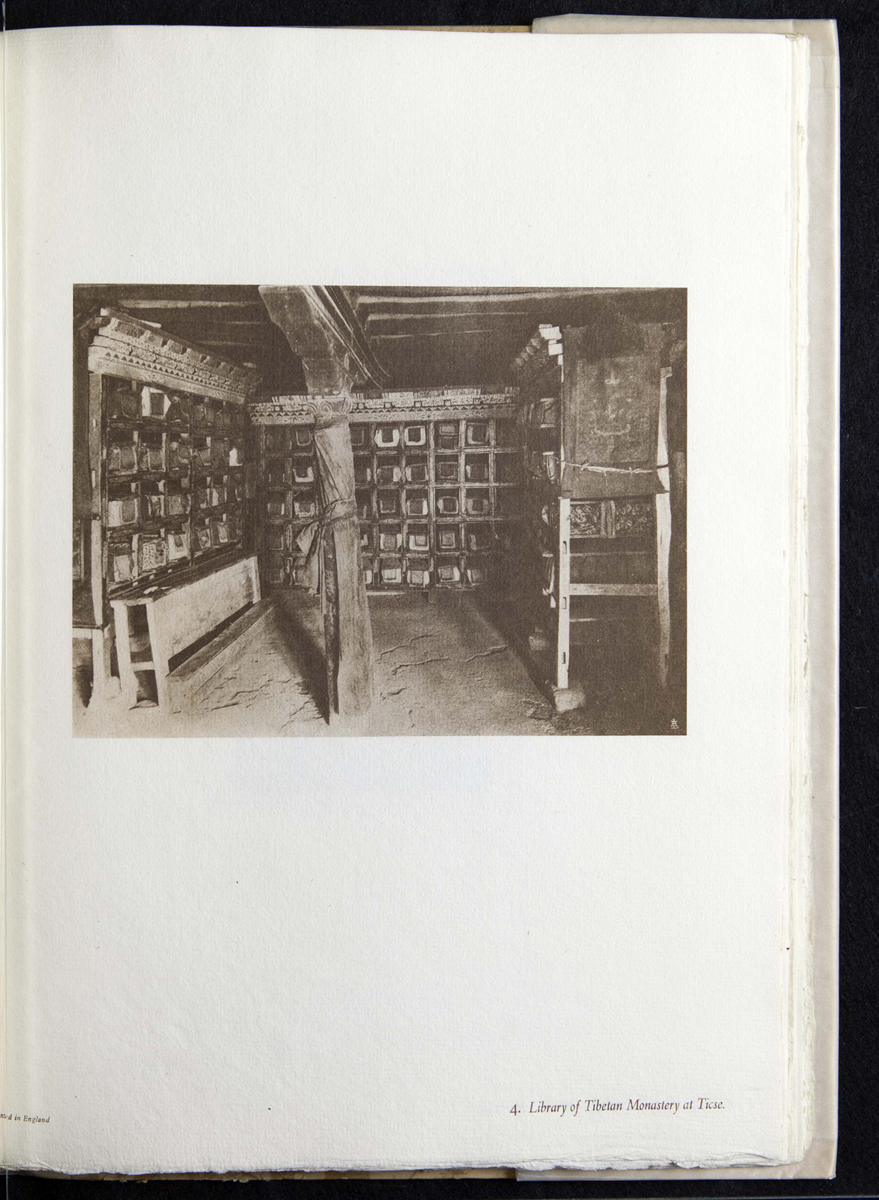
Figure 1. Frederic Kenyon, Ancient Books and Modern Discoveries, Chicago: The Caxton Club, 1927.
Z112 K42a
This Tibetan Library was part of a monastery. Religious communities played an important role in many cultures as sites for the study, copying, and preservation of texts. Many Tibetan prayers are printed from wood blocks, which are stored for repeated use. Wood block printing has a long history in the Far East, where it was invented, before the technology was exported to Europe in the 14th century. ↩
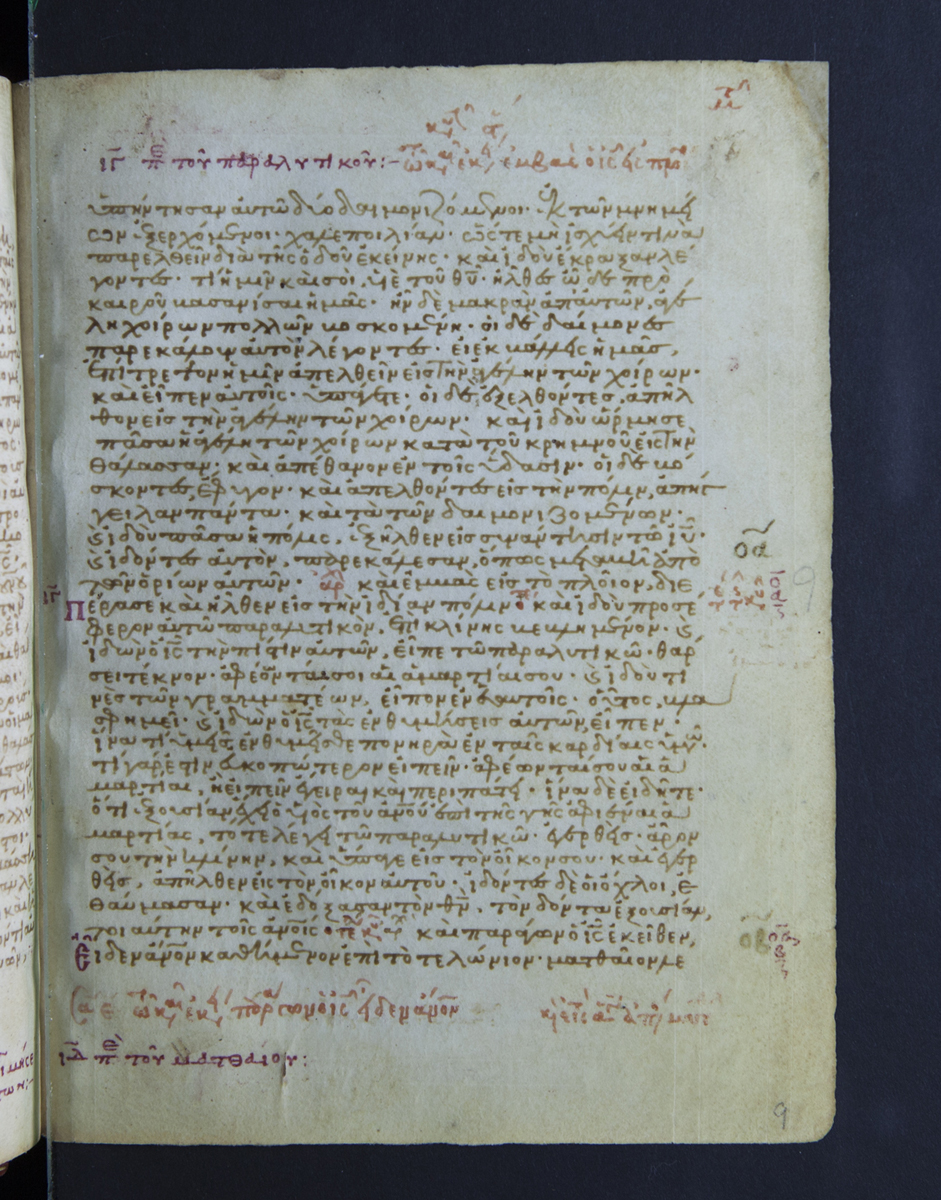

Figure 2. Manuscript of the New Testament in Greek. (Estimated ca. 1200)
Call Number: 170/ 347
This thirteenth-century Greek manuscript features lavishly colored portraits of Matthew, Mark, Luke, and John, each marking the start of their respective Gospel. Slight variations in the colored ink documents the writing of at least four different hands in both the main text and marginal notations. ↩
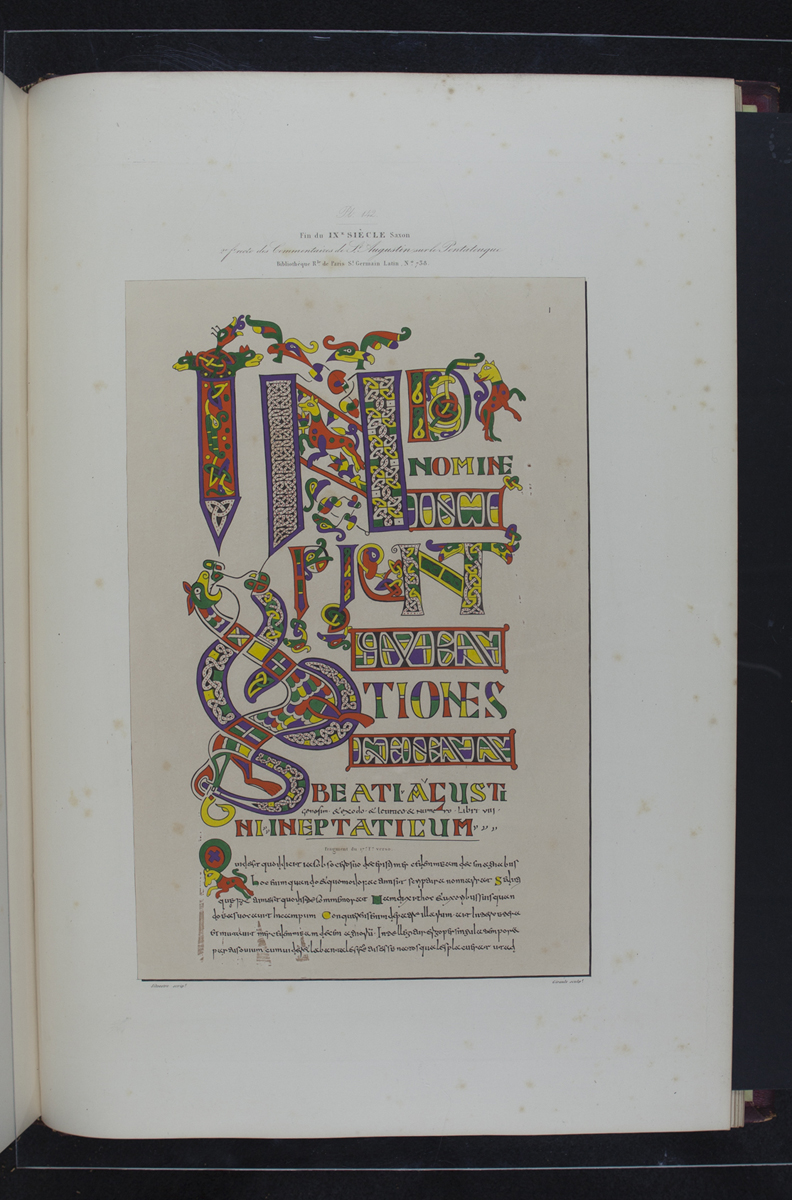
Figure 3. Joseph Balthaszar Silvestre, Universal Palaeography: or, Fac-similes of writings of all nations and periods. London: H. G. Bohn (1850).
* Z113 .S58pE
Facsimile page of a Saxon manuscript. The interlace patterns inside the strokes of the majuscules, and the animal heads on the ends of the letterforms and decorations, are typical of what is known as the “insular” style of illumination done in the British Isles. ↩
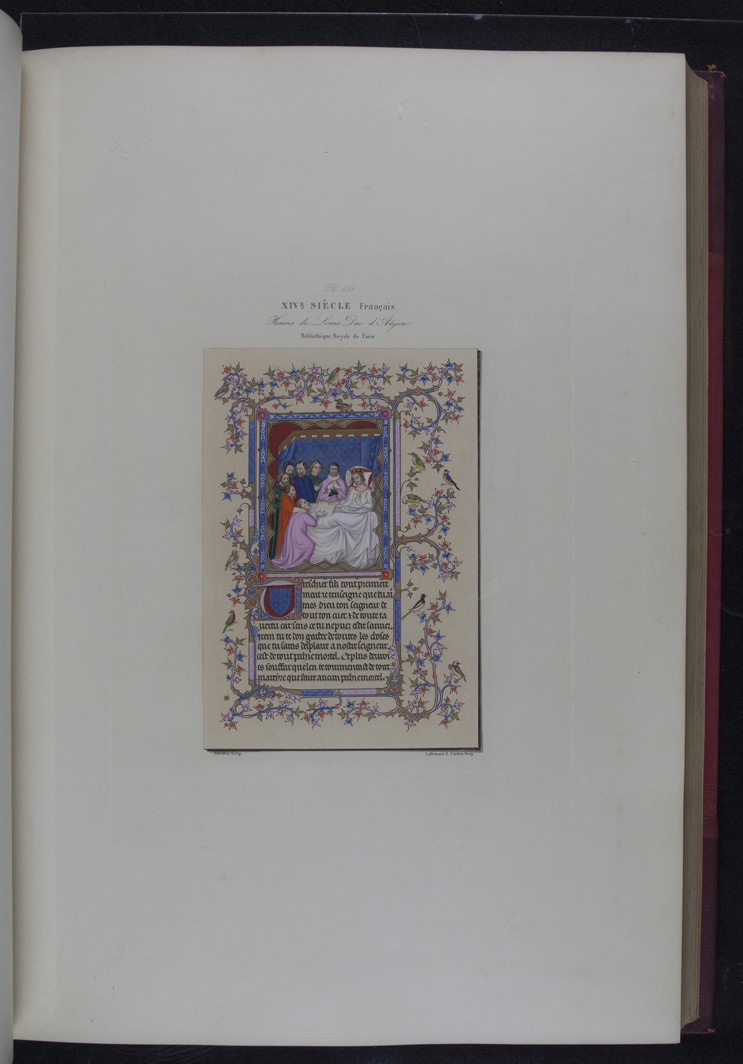
Figure 4. Joseph Balthaszar Silvestre, Universal Palaeography: or, Fac-similes of writings of all nations and periods. London: H. G. Bohn (1850).
* Z113 .S58pE
Facsimile of a page of a Book of Hours made in the 14th century for the Duc of Avignon. The colors, framing, delicate vine border, and naturalistic rendering of birds are all typical of the elegant work of French illuminators. The illumination is exquisite, and this kind of work was often sponsored by noble patrons—or created for presentation as gifts. ↩
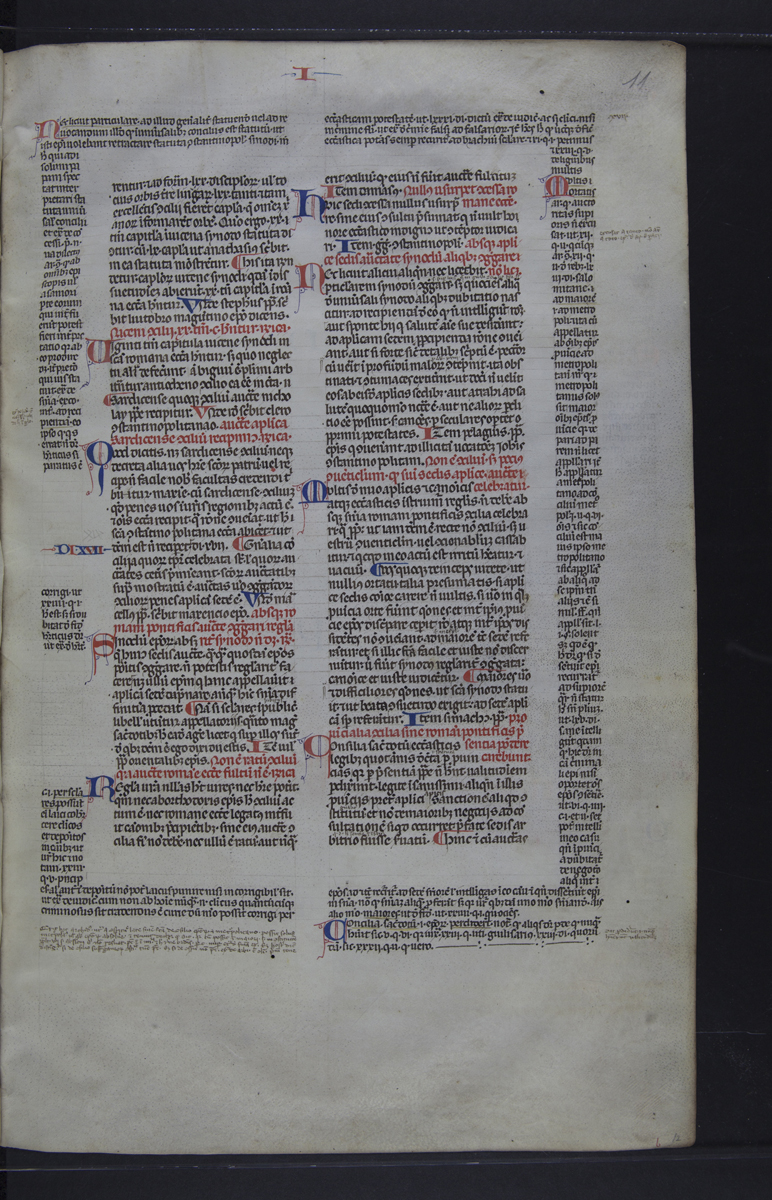
Figure 5. Decretum, with BARTOLOMEO DA BRESCIA, (d. 1258), Glossa ordinaria [manuscript]. France, likely Paris (1300-1325).
Call Number: ** 170/ 730
The two-column layout used throughout this fourteenth-century manuscript is common in handwritten manuscripts of this period, a design choice that would later be used in the earliest Western texts printed with movable type. As can be seen in some of the larger red and blue initial letters (most visible in the counter of the blue Q), illuminated letters were added after the completion of the main text and were initially marked by scribes with small placeholder letterforms. ↩
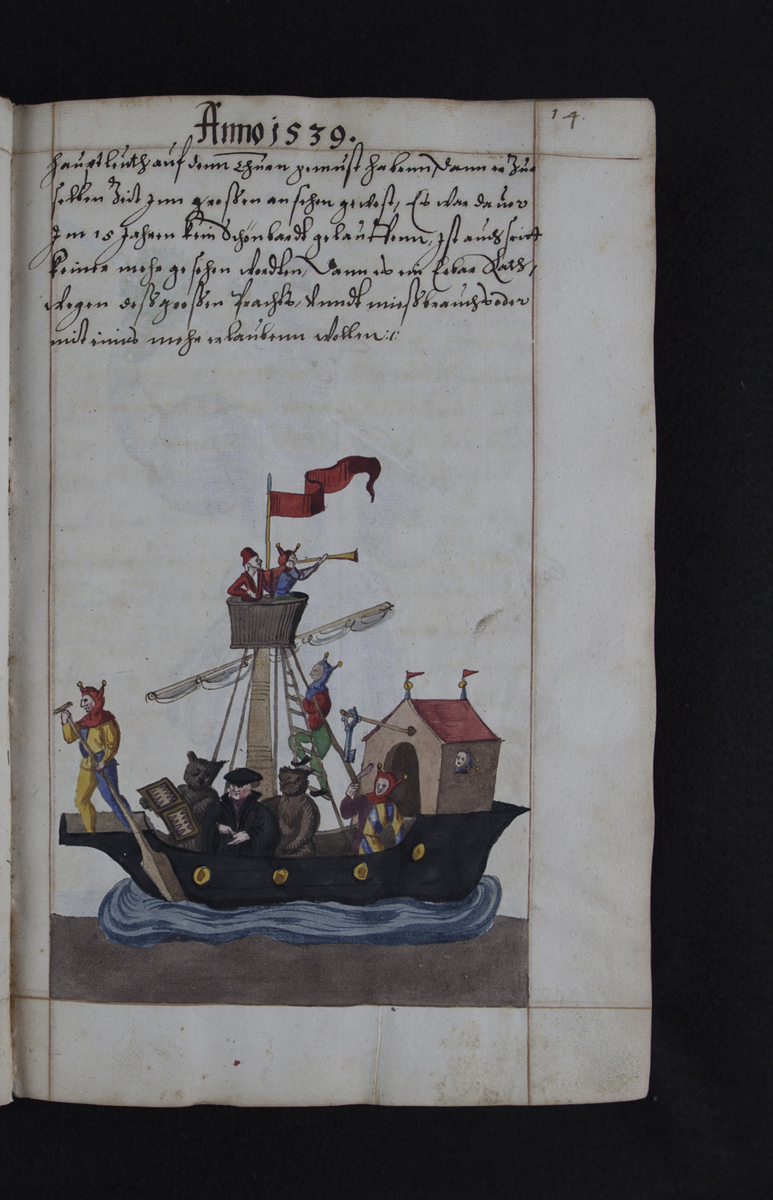
Figure 6. Der Annder Thaill: Nürumbergischer Cronica. (1530-1627).
Call Number: * 170/ 355
This unique book chronicles the events of Nuremburg from the year 1530 through 1627. Although various world events are included in the text, local events—such as this ship-shaped Carnival float from 1539—are much more thoroughly and meticulously documented, making this book a particularly useful resource in the study of historical Nuremburg. ↩
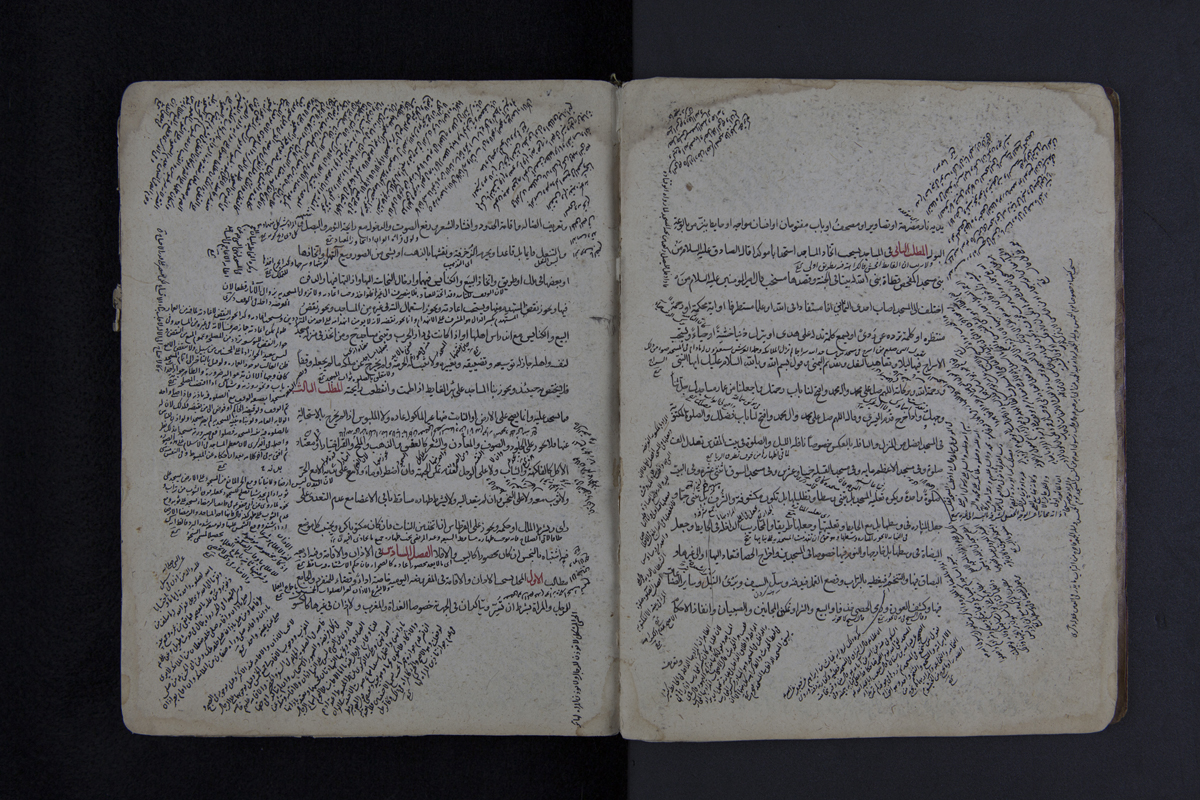
Figure 7. Ibn al-Mutahhr al-Hilli, al-Hasa ibn Yusuf, Kitāb Qawāʻid al-aḥkām fī maʻrifat al-ḥalāl wa-al-ḥarām. 13th century
Belt 170 / 870
This is a book of Islamic law and interpretation. The diagonal arrangement of writing is characteristic of Arabic manuscripts, in this case, a book of Islamic law. Note the lack of decoration, in keeping with Shi’ah customs and beliefs. ↩
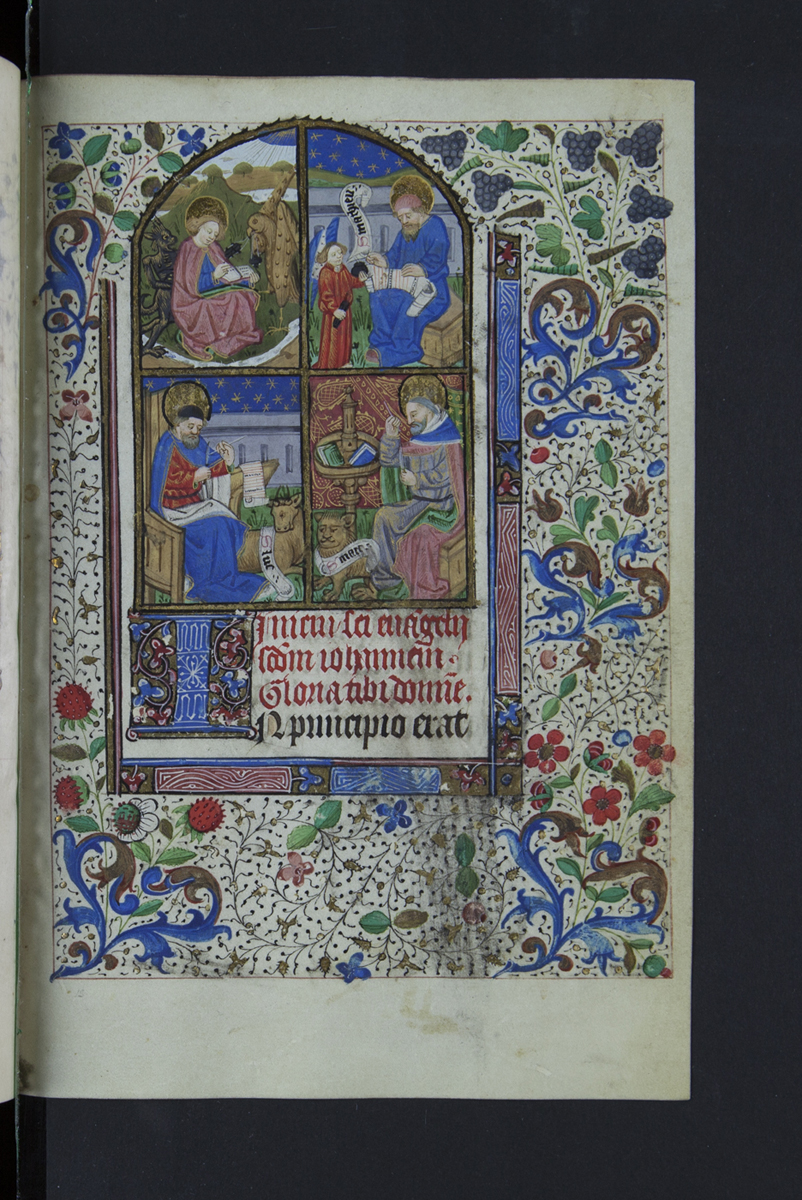
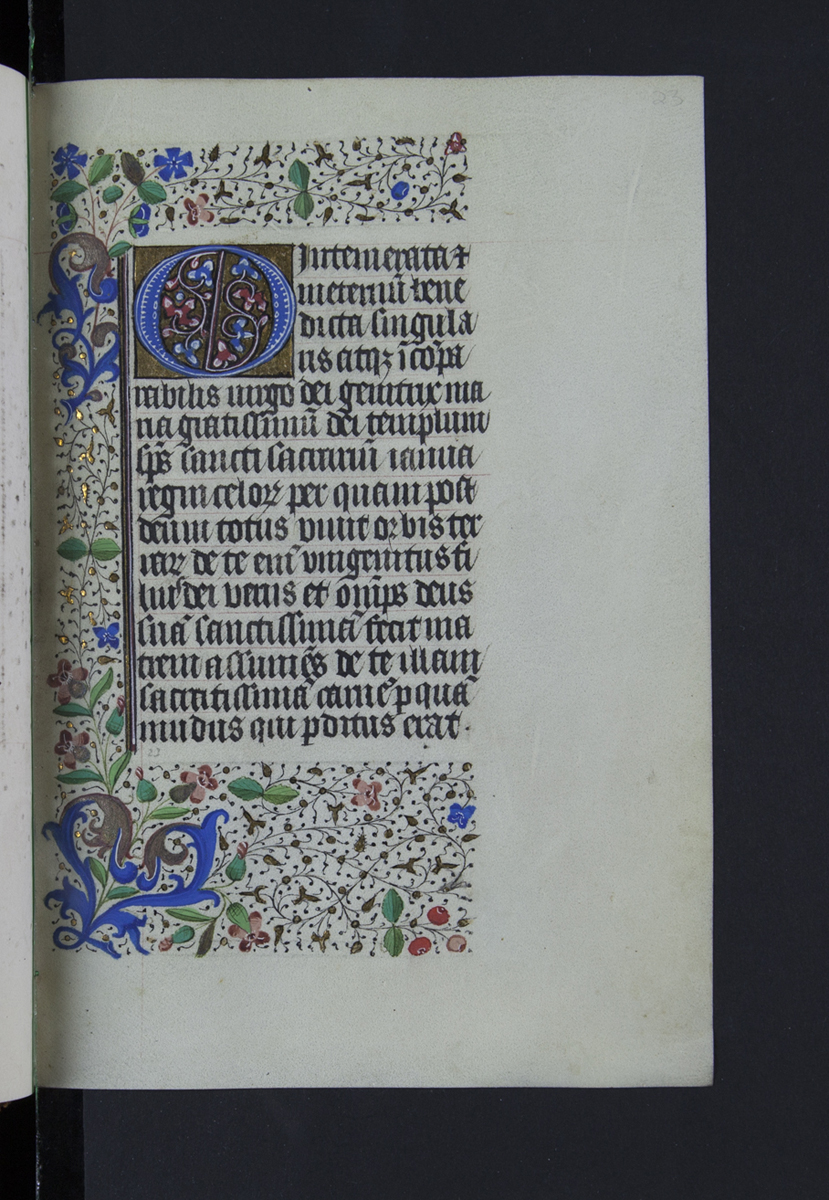
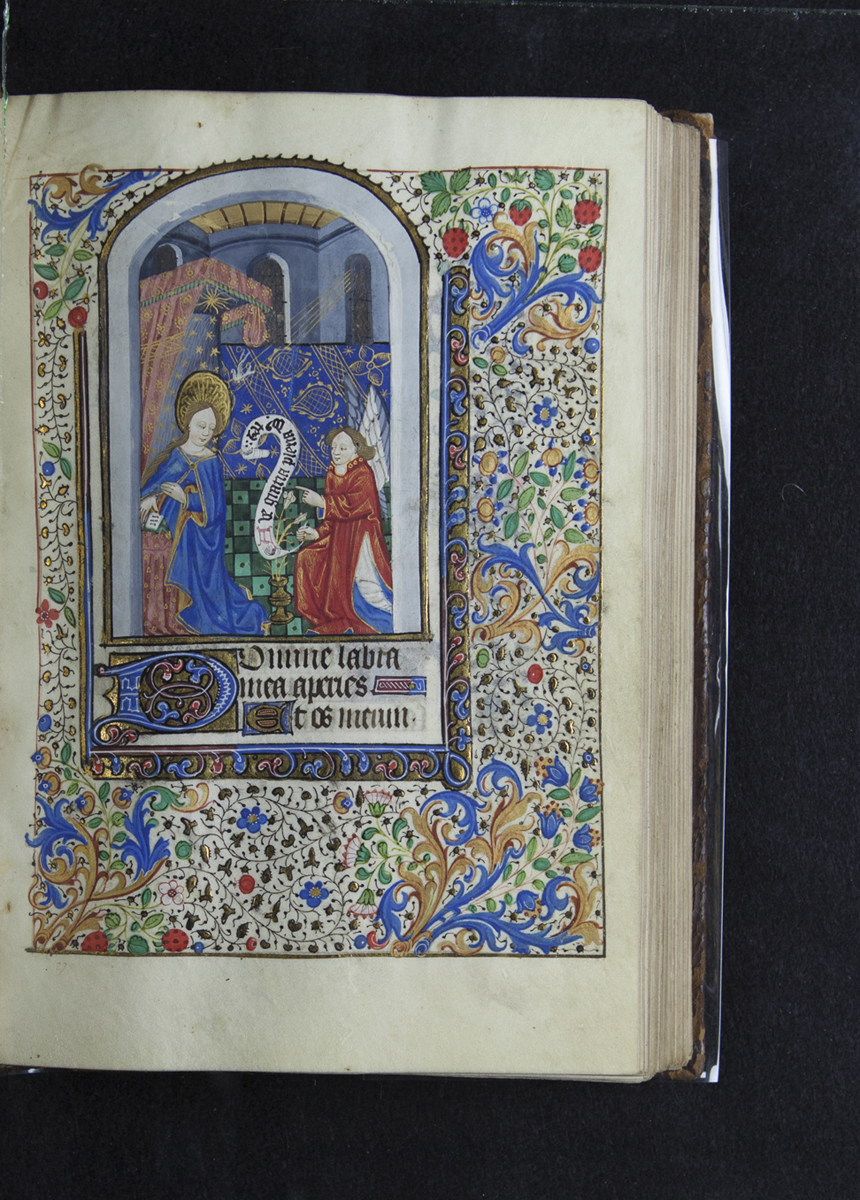
Figure 8. Book of Hours. Rouen, France (1400-1499).
Call Number: Belt MS 37
Books of Hours were one of the most commonly produced—and remain one of the most extant—genres of medieval manuscript. Lavishly decorated deluxe editions, such as this text from Rouen, were often quite expensive; however, smaller, more modest versions could be purchased for personal devotion at a relatively lower cost. ↩
All images are from book in the Charles E. Young Research Library at UCLA, unless otherwise noted.